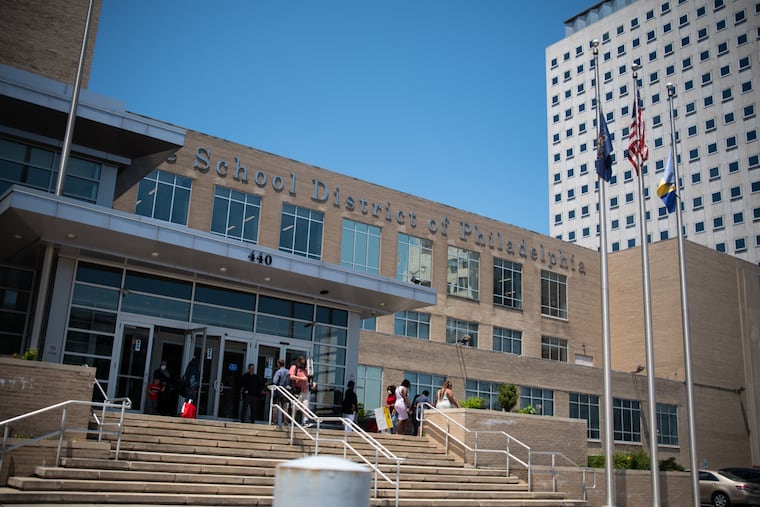Philly’s superintendent wants to offer extra pay for some teachers, and other takeaways from a City Council hearing
In the Philadelphia School District's annual budget hearing, officials also updated Council on asbestos closures and a coming enrollment decline. Recent discord was notably absent from the meeting.

The Philadelphia School District is suing the city. At least some City Council members think the district is incapable of adequately managing its facilities issues.
But in Tuesday’s four-hour public budget meeting that historically has produced fireworks, relations between the entities were notably cordial.
“I truly believe the seeds of sustainable collaboration have been planted,” school board president Reginald Streater said as he presented the district’s proposed $4.5 billion 2023-24 budget to Council.
» READ MORE: More teachers, more school safety officers: Here’s what’s planned for Philly’s $4.5 billion budget
Sprinkled throughout the school system’s annual budget hearing, though, were newly revealed hints about the superintendent’s forthcoming strategic plan, the ongoing asbestos work in city schools, and a push to hire extra counselors for some schools next year.
Here are some takeaways from the meeting:
Watlington wants to offer financial incentives to teachers
In Philadelphia, as in other large urban systems, the schools that struggle most often employ many new teachers and see the most turnover.
Superintendent Tony B. Watlington Sr. wants Philadelphia to be the fastest-improving city school district in the country. To do that, he thinks more teachers who have demonstrated a strong ability to grow student achievement need to be working in struggling schools.
Money will make that happen, Watlington said — “really significant improvement bonuses, really significant annual performance bonuses, and retention bonuses.”
Some say getting teachers to work in hard-to-staff schools is not about money, but about working conditions and other factors.
“I beg to differ,” Watlington said. “The districts that are getting better, they are doing some significant work with financial incentives.”
When the superintendent introduces his much-anticipated five-year strategic plan on May 25, he said, “we’re going to put that on the table.”
What’s happening at all the schools closed from asbestos?
Watlington and Chief Operating Officer Oz Hill gave a status update on the schools closed by damaged asbestos.
Building 21, the first school closed, on March 1, re-opened for students Tuesday after staff returned Monday.
C.W. Henry Elementary students and staff are still learning virtually, but a return is on the horizon; the school system is awaiting results of air quality tests, and once those pass muster with the Philadelphia Federation of Teachers’ environmental scientist, the school can re-open.
Mitchell students and staff have relocated to McMichael Elementary, in West Philadelphia; the Mitchell building, in Southwest Philadelphia, will be closed through the end of the school year.
Frankford High’s 900 students are all still learning virtually, and that school building will also be closed through June. But Hill said 10 classrooms at Olney High are being prepared to relocate Frankford’s students with disabilities, and that those students and teachers could relocate next week.
Though the school closed nearly a month ago, no alternate location for the rest of the school has yet been identified, though work is still ongoing, Hill said.
Environmental conditions in most district schools put “swing space” at a premium, officials said. In all, 295 district schools have asbestos-containing materials.
Six schools have closed this school year because of damaged asbestos.
Next year there will be fewer students but with more staff
The school system, whose enrollment is 113,443 this year, projects a 0.5% enrollment drop for next year, officials said.
Even so, the district wants to hire more staff and spend more money per pupil.
Current plans include 15,037 school-based staffers for the 2023-24 school year, vs. 14,774 this year. Of that number, 8,690 will be teachers, up from 8,543 this year.
That’s not irresponsible spending, Watlington said. The district has been underfunded for decades, a Pennsylvania Commonwealth Court judge concluded in a historic school-funding ruling that came earlier this year.
After years of cuts — including the layoff of thousands of teachers, counselors, nurses, school secretaries and assistant principals — “it’s taken years to build back up to even an appropriate level of staffing, and in some areas, we’re still understaffed,” Watlington said.
Of note: Watlington said the school system will hire 15 additional counselors for the neediest schools, including those hit hard by the gun violence and opioid epidemics.
If any hostility exists, you wouldn’t know it
Notable in their absence were any mention of the school district’s lawsuit over a new legislation that gives the city oversight over environmental conditions inside schools, and Councilmember Isaiah Thomas’ push to give an independent authority control over issuing bonds and managing district repairs.